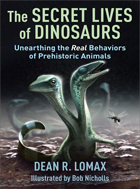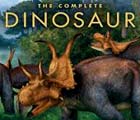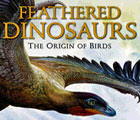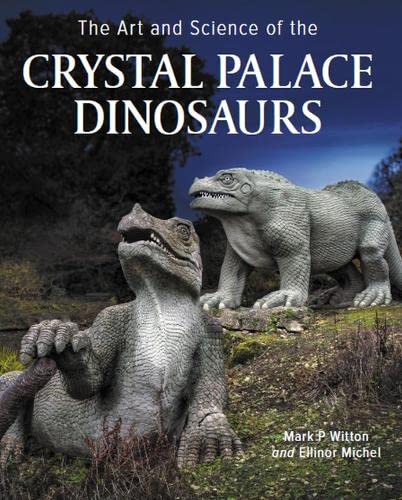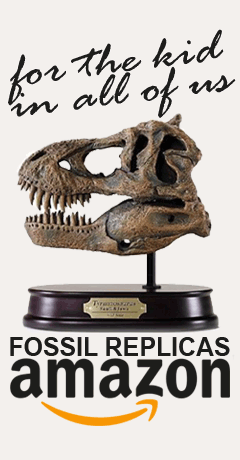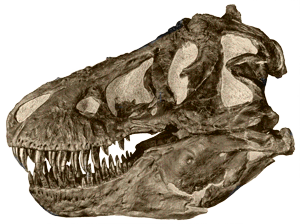
Dinosauria
Saurischia
Theropoda
Tetanurae
Coelurosauria
Tyrannoraptora
Tyrannosauroidea
Tyrannosauridae
Pronunciation: ty-RAN-o-SOR-uh-day
Author: Henry Fairfield Osborn
Year: 1906
Meaning: Tyrant lizard family (see etymology)
Locomotion: Bipedal (two legs)
Synonyms: Deinodontidae (Cope, 1866),
Aublysodontidae (Nopcsa, 1928),
Shanshanosauridae (Dong, 1977)
Author: Henry Fairfield Osborn
Year: 1906
Meaning: Tyrant lizard family (see etymology)
Locomotion: Bipedal (two legs)
Synonyms: Deinodontidae (Cope, 1866),
Aublysodontidae (Nopcsa, 1928),
Shanshanosauridae (Dong, 1977)
[Sereno, 2005]Definition
The least inclusive clade containing Tyrannosaurus rex, Gorgosaurus libratus and Albertosaurus sarcophagus.
About
Originally named "Deinodontidae" by Edward Drinker Cope in 1866, Tyrannosauridae is a group of large-bodied, multi-ton coelurosaurian theropods with massive skulls, forward-pointing eyes for binocular vision, powerful legs with what boffins call an "arctometatarsus", and pathetically small but powerful arms with only two functional fingers.
Tyrannosauridae contains two sub-families; Albertosaurinae (the slender tyrannosaurids, including Albertosaurus and Gorgosaurus) and Tyrannosaurinae (the robust tyrannosaurids, including Tarbosaurus and Tyrannosaurus ), and while all were very large by modern predator standards some were "only" nine meters in length and one (Nanuqsaurus) was a mere five and a half.
Unlike the smaller, cosmopolitan Tyrannosauroidea — the group which they fall inside of — tyrannosaurids are found exclusively in Late Cretaceous formations of Asia and North America where they were always the top predators in their ecosystem.
Until recently, it was thought that their relatively short, rounded and robust snouts with massive bone-crushing teeth and an expanded rear of the skull which allowed for huge muscle attachment and fully forward-pointing eyes appeared around 70 million years ago. But the discovery of Lythronax argestes in Utah's Mid-Campagnian-aged Wahweap Formation pushed the origin of tyrannosaurid-skull-robustness back some 10 million years.
Click here to view Dinochecker's A-Z list of tyrannosaurids.
Etymology
Tyrannosauridae is derived from the Greek "tyrannos" (tyrant) + Greek "sauros" (lizard) + Latin "-idae" (family).
Relationships
References
• Larson PL and Carpenter K (2008) "Tyrannosaurus Rex, the Tyrant King".
• Parrish M, Molnar RE, Currie PJ and Koppelhus EB (2013) "Tyrannosaurid Paleobiology".
• Horner JR and Padian K (2004) "Age and growth dynamics of Tyrannosaurus rex". Proceedings of the Royal Society of London B. 271(1551): 1875–1880. DOI: 10.1098/rspb.2004.2829
• McCrea RT, Buckley LG, Farlow JO, Lockley MG, Currie PJ, Matthews NA and Pemberton SG (2014) "A 'Terror of Tyrannosaurs': The First Trackways of Tyrannosaurids and Evidence of Gregariousness and Pathology in Tyrannosauridae". PLOS ONE. 9(7): e103613. doi:10.1371/journal.pone.0103613
• Currie PJ, Hurum JH and Sabath K (2003) "Skull structure and evolution in tyrannosaurid phylogeny". Acta Palaeontologica Polonica. 48(2): 227–234.
• Carr TD, Varricchio DJ, Sedlmayr JC, Roberts EM and Moore JR (2017) "A new tyrannosaur with evidence for anagenesis and crocodile-like facial sensory system". Scientific Reports. 7(1): 44942. doi:10.1038/srep44942
• Abler WL (2001) "A kerf-and-drill model of tyrannosaur tooth serrations". In Tanke and Carpenter (eds.) "Mesozoic Vertebrate Life".
• Holtz TR jr. (1994) "The phylogenetic position of the Tyrannosauridae: implications for theropod systematics". Journal of Paleontology. 68(5): 1100–1117. doi:10.1017/S0022336000026706
• Randall DK (2022) "The Monster's Bones: The Discovery of T. Rex and How It Shook Our World".
• Brown CM, Currie PJ and Therrien F (2022) "Intraspecific facial bite marks in tyrannosaurids provide insight into sexual maturity and evolution of bird-like intersexual display". Paleobiology 48(1): 2-43. DOI: 10.1017/pab.2021.29
• Padian K (2022) "Why tyrannosaurid forelimbs were so short: An integrative hypothesis".
Acta Palaeontologica Polonica, 67(1): 63–76. DOI: 10.4202/app.00921.2021.





